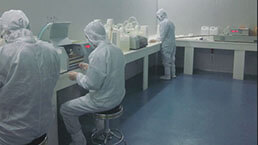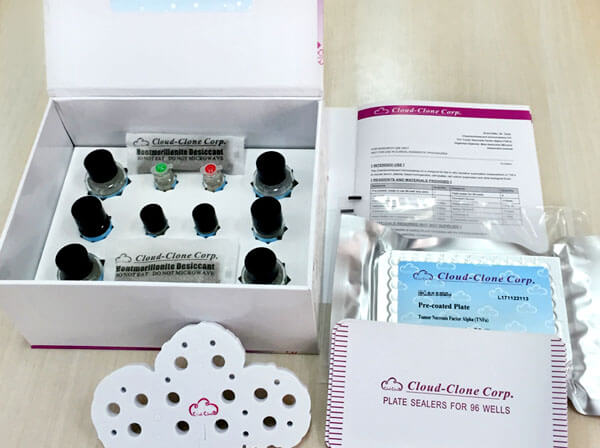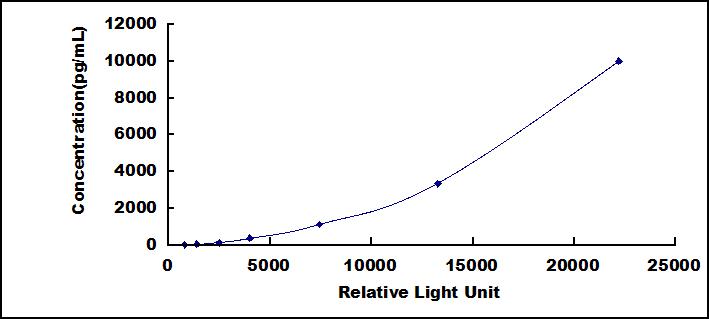CLIA Kit for Connective Tissue Growth Factor (CTGF) 

CCN2; HCS24; IGFBP8; NOV2; Insulin-Like Growth Factor-Binding Protein 8; Hypertrophic Chondrocyte-Specific Protein 24; CCN Family Member 2
- UOM
- FOB US$ 605.00 US$ 864.00 US$ 3,888.00 US$ 7,344.00 US$ 60,480.00
- Quantity
Overview
Properties
- Product No.SCA010Mu
- Organism SpeciesMus musculus (Mouse) Same name, Different species.
- ApplicationsChemiluminescent immunoassay for Antigen Detection.
Research use only - DownloadInstruction Manual
- CategoryCytokine
Sign into your account
Share a new citation as an author
Upload your experimental result
Review

Contact us
Please fill in the blank.
Recovery
Matrices listed below were spiked with certain level of recombinant Connective Tissue Growth Factor (CTGF) and the recovery rates were calculated by comparing the measured value to the expected amount of Connective Tissue Growth Factor (CTGF) in samples.
| Matrix | Recovery range (%) | Average(%) |
| serum(n=5) | 93-102 | 96 |
| EDTA plasma(n=5) | 90-104 | 99 |
| heparin plasma(n=5) | 78-101 | 82 |
Precision
Intra-assay Precision (Precision within an assay): 3 samples with low, middle and high level Connective Tissue Growth Factor (CTGF) were tested 20 times on one plate, respectively.
Inter-assay Precision (Precision between assays): 3 samples with low, middle and high level Connective Tissue Growth Factor (CTGF) were tested on 3 different plates, 8 replicates in each plate.
CV(%) = SD/meanX100
Intra-Assay: CV<10%
Inter-Assay: CV<12%
Linearity
The linearity of the kit was assayed by testing samples spiked with appropriate concentration of Connective Tissue Growth Factor (CTGF) and their serial dilutions. The results were demonstrated by the percentage of calculated concentration to the expected.
| Sample | 1:2 | 1:4 | 1:8 | 1:16 |
| serum(n=5) | 80-102% | 97-104% | 96-103% | 91-99% |
| EDTA plasma(n=5) | 97-105% | 88-102% | 79-102% | 95-105% |
| heparin plasma(n=5) | 84-102% | 84-98% | 78-92% | 91-98% |
Stability
The stability of kit is determined by the loss rate of activity. The loss rate of this kit is less than 5% within the expiration date under appropriate storage condition.
To minimize extra influence on the performance, operation procedures and lab conditions, especially room temperature, air humidity, incubator temperature should be strictly controlled. It is also strongly suggested that the whole assay is performed by the same operator from the beginning to the end.
Reagents and materials provided
| Reagents | Quantity | Reagents | Quantity |
| Pre-coated, ready to use 96-well strip plate | 1 | Plate sealer for 96 wells | 4 |
| Standard | 2 | Standard Diluent | 1×20mL |
| Detection Reagent A | 1×120µL | Assay Diluent A | 1×12mL |
| Detection Reagent B | 1×120µL | Assay Diluent B | 1×12mL |
| Substrate A | 1×10mL | Substrate B | 1×2mL |
| Wash Buffer (30 × concentrate) | 1×20mL | Instruction manual | 1 |
Assay procedure summary
1. Prepare all reagents, samples and standards;
2. Add 100µL standard or sample to each well. Incubate 1 hours at 37°C;
3. Aspirate and add 100µL prepared Detection Reagent A. Incubate 1 hour at 37°C;
4. Aspirate and wash 3 times;
5. Add 100µL prepared Detection Reagent B. Incubate 30 minutes at 37°C;
6. Aspirate and wash 5 times;
7. Add 100µL Substrate Solution. Incubate 10 minutes at 37°C;
8. Read RLU value immediately.

Test principle
The microplate provided in this kit has been pre-coated with an antibody specific to Connective Tissue Growth Factor (CTGF). Standards or samples are then added to the appropriate microplate wells with a biotin-conjugated antibody specific to Connective Tissue Growth Factor (CTGF). Next, Avidin conjugated to Horseradish Peroxidase (HRP) is added to each microplate well and incubated. Then the mixture of substrate A and B is added to generate glow light emission kinetics. Upon plate development, the intensity of the emitted light is proportional to the Connective Tissue Growth Factor (CTGF) level in the sample or standard.;
Giveaways
Increment services
-
 Single-component Reagents of Assay Kit
Single-component Reagents of Assay Kit
-
 Lysis Buffer Specific for ELISA / CLIA
Lysis Buffer Specific for ELISA / CLIA
-
 Quality Control of Kit
Quality Control of Kit
-
 CLIA Kit Customized Service
CLIA Kit Customized Service
-
 Disease Model Customized Service
Disease Model Customized Service
-
 Serums Customized Service
Serums Customized Service
-
 TGFB1 Activation Reagent
TGFB1 Activation Reagent
-
 Real Time PCR Experimental Service
Real Time PCR Experimental Service
-
 Streptavidin
Streptavidin
-
 Fast blue Protein Stain solution
Fast blue Protein Stain solution
-
 Single-component Reagents of FLIA Kit
Single-component Reagents of FLIA Kit
-
 Streptavidin-Agarose Beads
Streptavidin-Agarose Beads
Citations
- Promotion of bone formation by naringin in a titanium particle-induced diabetic murine calvarial osteolysis modelPubMed: 19824055
- Connective tissue growth factor hammerhead ribozyme attenuates human hepatic stellate cell functionPubMed: PMC2726461
- Activation of JNK Signaling Mediates Connective Tissue Growth Factor Expression and Scar Formation in Corneal Wound HealingPlosone: 0032128
- Clinical significance of inflammatory and fibrogenic cytokines in diabetic nephropathyScienceDirect: S0009912012000987
- Connective tissue growth factor (CTGF/CCN2): A protagonist in cardiac allograft vasculopathy development?PubMed: S1053249812010121
- The Intervention Effect of Rosiglitozone in Ovarian Fibrosis of PCOS RatsBesjournal: Source
- Concentrations of connective tissue growth factor in patients with nonalcoholic fatty liver disease: Association with liver fibrosisPubMed: 22846210
- Clinical significance of connective tissue growth factor in hepatitis B virus-induced hepatic fibrosisPubMed: PMC3351780
- Multitargeted protective effect of Abacopteris penangiana against carrageenan-induced chronic prostatitis in rats.Pubmed: 24211397
- Cytokine levels as biomarkers of radiation fibrosis in patients treated with breast radiotherapyRo-journal: Source
- Knock Out of S1P3 Receptor Signaling Attenuates Inflammation and Fibrosis in Bleomycin-Induced Lung Injury Mice ModelPubmed:Pmc4157792
- Connective tissue growth factor and cardiac diastolic dysfunction: human data from the Taiwan Diastolic Heart Failure Registry and molecular basis by cellular and animal modelsPubmed:24464932
- Connective Tissue Growth Factor is a Target of Notch Signaling in Cells of the Osteoblastic LineagePubmed:24792956
- Disruption of collagen homeostasis can reverse established age-related myocardial fibrosisPubmed:25701883
- Beneficial effects of combined ursodeoxycholic acid and angiotensin-II type 1 receptor blocker on hepatic fibrogenesis in a rat model of nonalcoholic steatohepatitisPubMed: 26190501
- Suppression of connective tissue growth factor mediates the renoprotective effect of Sitagliptin rather than Pioglitazone in type 2 diabetes mellitusPubmed:27049870
- TGF-β and Physiological Root Resorption of Deciduous Teeth.pubmed:28035998
- Fibrosis of extracellular matrix is related to the duration of the disease but is unrelated to the dynamics of collagen metabolism in dilated cardiomyopathypubmed:27516211
- Left ventricular reverse remodeling is not related to biopsy-detected extracellular matrix fibrosis and serum markers of fibrosis in dilated cardiomyopathy, regardless of the definition used for LVRRpubmed:28004175
- The relationship between anti-vascular endothelial growth factor and fibrosis in proliferative retinopathy: clinical and laboratory evidencepubmed:27531356
- Molecular mechanisms underlying fibrosis and elastin destruction in childhood interstitial lung diseasespubmed:27686729
- Cardioprotection against Heart Failure by Shenfu Injection via TGF-β/Smads Signaling Pathwaypubmed:28698735
- Left ventricular reverse remodeling is not related to biopsy‑detected extracellular matrix fibrosis and serum markers of fibrosis in dilated cardiomyopathy, regardless of the definition used for LVRR10.1007/s00380-016-0930-y
- 12-month patterns of serum markers of collagen synthesis, transforming growth factor and connective tissue growth factor are similar in new-onset and chronic dilated cardiomyopathy in patients both with and without cardiac fibrosis.pubmed:28460256
- Prognostic value of fibrosis-related markers in dilated cardiomyopathy: A link between osteopontin and cardiovascular events.pubmed:29120858
- Sustained β-AR stimulation induces synthesis and secretion of growth factors in cardiac myocytes that affect on cardiac fibroblast activationPubmed:29107793
- Substrate Stiffness Influences the Time Dependence of CTGF Protein Expression in Müller CellsPubmed:30123889
- TGFβ mediates collagen production in human CRSsNP nasal mucosa‐derived fibroblasts through Smad2/3‐dependent pathway and CTGF induction and secretionPubmed: 30426494
- Combination of Plasma Biomarkers and Clinical Data for the Detection of Myocardial Fibrosis or Aggravation of Heart Failure Symptoms in Heart Failure with …Pubmed: 30413105
- Macrophage hypoxia signaling regulates cardiac fibrosis via Oncostatin MPubmed: 31249305
- Circulating Connective Tissue Growth Factor Is Associated with Diastolic Dysfunction in Patients with Diastolic Heart FailurePubmed: 31466059
- CTGF Attenuates Tendon-Derived Stem/Progenitor Cell AgingPubmed: 31827530
- Small-Dose Sunitinib Modulates p53, Bcl-2, STAT3, and ERK1/2 Pathways and Protects against Adenine-Induced NephrotoxicityPubmed: 33212804
- Lysophosphatidic acid as a regulator of endometrial connective tissue growth factor and prostaglandin secretion during estrous cycle and endometrosis in the …Pubmed: 32943074
- MicroRNAs and ventricular remodeling in aortic stenosisPubmed: 32682570
- Manuscript title Microparticles Containing MiR-625-5p In Coronary Artery Reduce Myocardial Fibrosis After Myocardial Infarction
- High carbohydrate high fat diet causes arterial hypertension and histological changes in the aortic wall in aged rats: The involvement of connective tissue growth …34455071
- Hepatocyte-specific Smad4 deficiency alleviates liver fibrosis via the p38/p65 pathway








